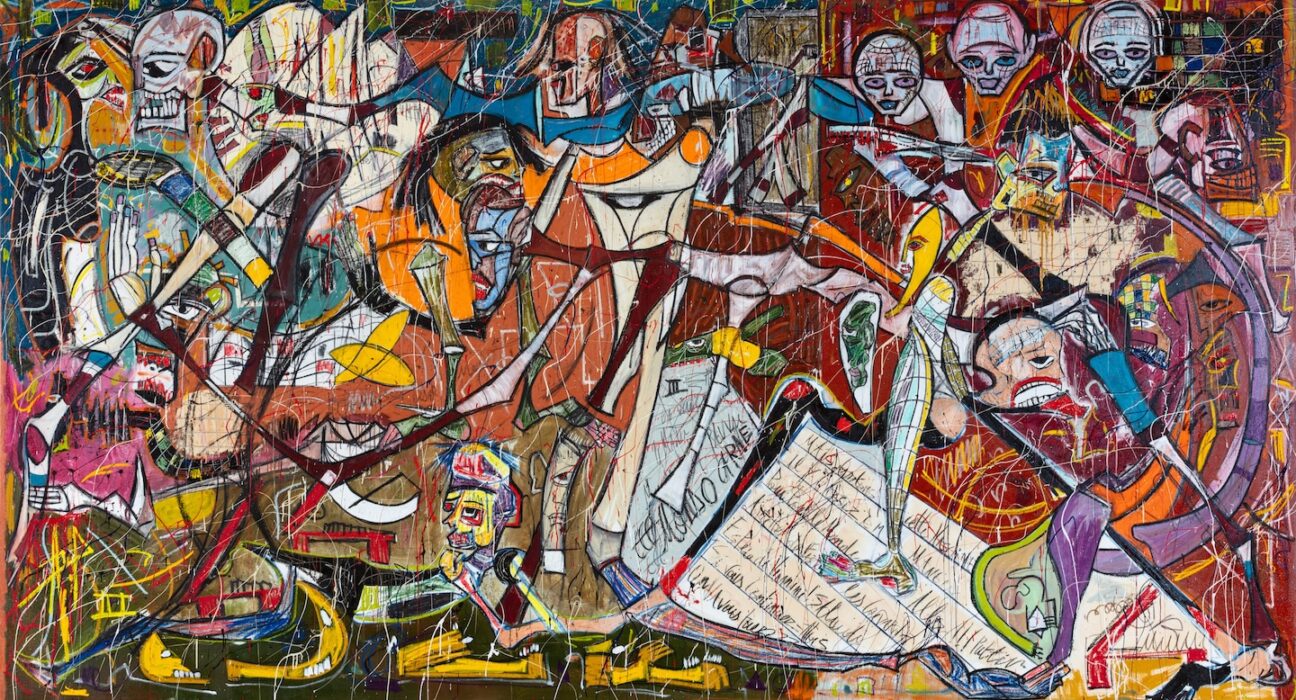Diop’s style is raw and loose, and his pieces incorporate found objects — all qualities common in the work displayed elsewhere in the building. Based in Vienna, Diop makes work that speaks to the Black experience, as do many of the contributors to the parallel show. And Diop is a former artist-in-residence at the Rubell’s Miami facility, like three others whose work is on display in the D.C. branch.
Selected from the extensive art collection built by Mera and Don Rubell and their son, Jason Rubell, both shows excavate cultural history while addressing contemporary concerns. Diop parodies such well-known European paintings as Manet’s “Olympia,” which depicts a reclining nude White woman with a Black maid behind her, while repeatedly inserting the covers of books by his partial namesake, Senegalese historian and anthropologist Cheikh Anta Diop. Trash found in the neighborhood of Miami’s Rubell Museum features in some of the pieces, which were made there. The effect is both exuberant and destabilizing, as Diop proclaims his prerogative to remake European art from an Afrocentric perspective.
Several of the artists offer defiantly large and ornate portraits of Black people. Painter Mickalene Thomas’s women, some partially nude, are adorned with multicolored rhinestones. There’s even more bare flesh in Ethiopia-born Tesfaye Urgessa’s huge paintings of entwined bodies, whose meaty quality recalls British painter Francis Bacon.
Amoako Boafo and Otis Kwame Kye Quaicoe, both Ghanaian-born and former Rubell resident artists, portray Black people in bold attire against backdrops that are, respectively, flat and brightly colorful or thickly impastoed and white. Boafo, a pop-expressionist, gives his subjects smeary skin; the pop-realist Quaicoe depicts complexions that are glossy and literally black.
Two local Black women artists portray their peers in very different ways. Rozeal (formerly known as Iona Rozeal Brown) takes her inspiration, and her poses, from Edo-period Japanese woodblock prints. February James gives an ominous vibe to portraits of everyday people, depicting them with grim expressions and threatening teeth.
Many of the featured artists are indebted to comics and cartoons. Superman and a baseball player are among the American icons that appear in often text-heavy sketches by Raymond Pettibon, who’s probably best known for the artwork he made for Black Flag, his brother’s Los Angeles punk band. While they’re painted rather than drawn, there’s a cartoonish quality to Clayton Schiff’s pictures of sad-sack characters that his statement calls “typically stand-ins for myself.”
Also cartoony are the people in Jesse Mockrin’s oil-on-linen paintings, although they’re rendered in a painstaking neoclassical style that’s anything but characteristic of the Rubells’ usual holdings. Mockrin’s pictures are perhaps the gentlest work in the show, although there’s a kindred delicacy to William Kentridge’s hand-drawn animated video, in which water images ebb and flow.
Panels from the sort of romance comics once pillaged by pop artist Roy Lichtenstein appear in Allison Zuckerman’s part-digital collage paintings. But Zuckerman, another former Rubell resident artist, also sometimes includes images of women derived from pornography. That gives her work an affinity with that of Cajsa von Zeipel, a holdover from the museum’s inaugural installation whose work features nearly nude mannequins who cavort on a bed with photo and video gear as if both making and becoming a porn video.
There are no representations of people in John Miller’s found-object tableau, “A Refusal to Accept Limits,” another work that has been on view since the museum opened. Greco-Roman columns, an archway and an obelisk are the defining elements of the large installation, in which everything is painted gold. Among the smaller objects are plastic bottles and toy guns and such tools as saws and scythes. What seems at first to be a simulated ancient ruin turns out be an assemblage of recently manufactured things, a pileup of gilded junk. Even at its most seemingly classical, “Singular Views” is aggressively contemporary.
Singular Views: 25 Artists
Alexandre Diop: Jooba Jubba, l’Art du Defi, the Art of Challenge
Rubell Museum, 65 I St. SW. 202-964-8254. rubellmuseum.org/dc.
Dates: Through October 2024.
Prices: $15; $12 for seniors; $10 for students and children; free for D.C. residents, military personnel, EBT cardholders and visitors with disabilities. Wednesday-Friday admission is by pay-what-you-wish donation.

